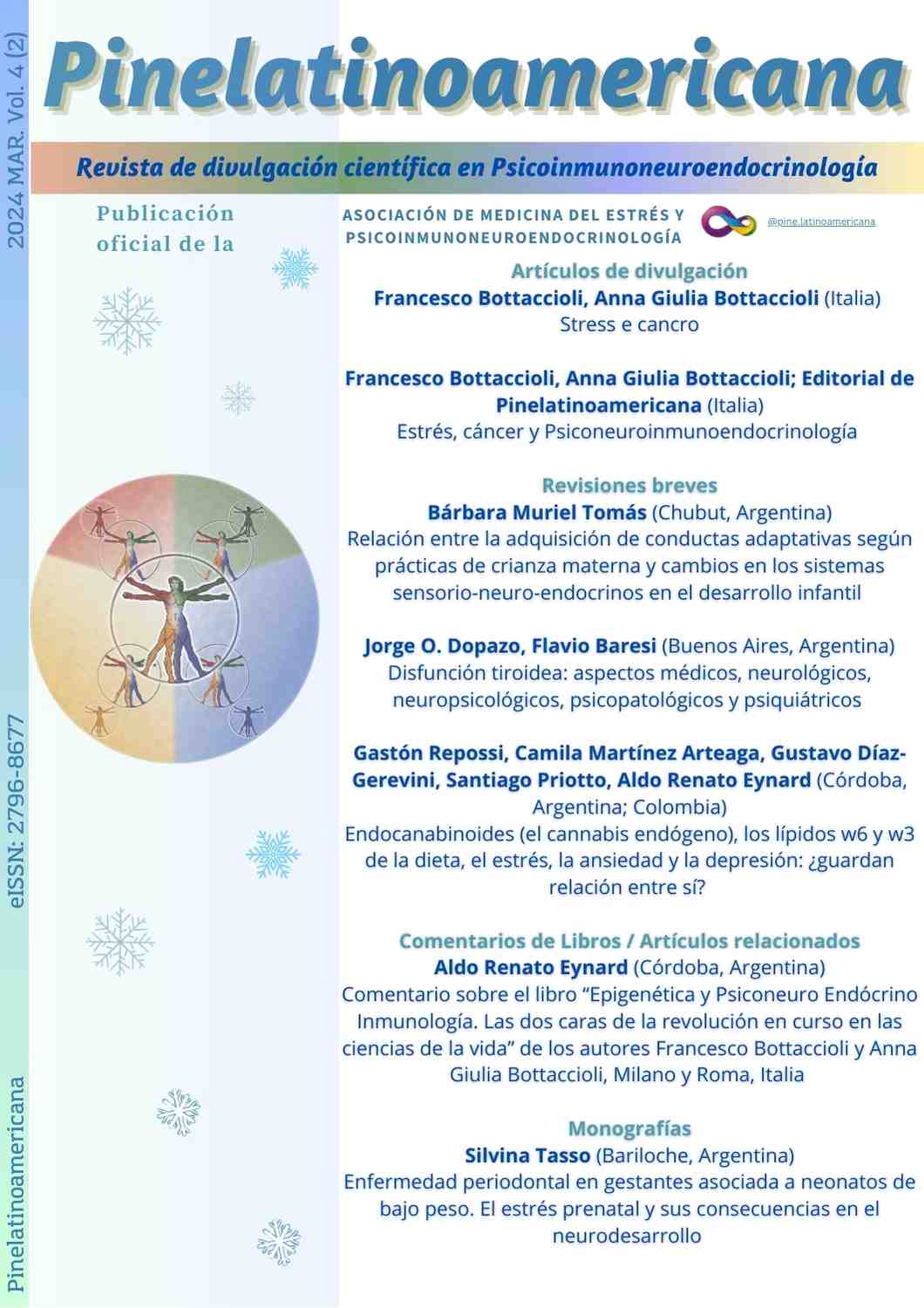Abstract
Se revisa con criterio estadístico una muestra de pacientes, niños y jóvenes, con discapacidad mental y registros de disfunción tiroidea. Son analizados y correlacionados signos y síntomas clínicos de las diversas formas de disfunción tiroidea (hipotiroidismo e hipertiroidismo). Se tienen en cuenta los parámetros clínicos, de laboratorio y otros procedimientos para precisar el diagnóstico precoz y su tratamiento temprano. De los resultados obtenidos se extraen conclusiones y recomendaciones en el marco de la bibliografía sobre la temática.
Riferimenti bibliografici
Amr, N. H. (2018). Thyroid Disorders in Subjects with Down Syndrome: An Update. Acta bio-medica: Atenei Parmensis, 89(1), 132–139. https://doi.org/10.23750/abm.v89i1.7120
American Psychiatric Association. (2014). DSM-5-TR Manual Diagnóstico y Estadístico de los Trastornos Mentales. (5 ta. ed.). Médica Panamericana.
Aydin, A., Cemeroglu, A. P. y Baklan, B. (2004). Thyroxine-induced hypermotor seizure. Seizure, 13(1), 61–65. https://doi.org/10.1016/s1059-1311(03)00054-2
Boullosa, J. (2002). Eje córtico-límbico-hipotálamo-hipófiso-tiroideo. En: Marquez Lopez Mato, A. Psiconeuroendocrinología: aspectos epistemológicos, clínicos y terapéuticos. (pp. 431-442). Editorial Polemos.
Calzà, L., Baldassarro, V. A., Fernandez, M., Giuliani, A., Lorenzini, L. y Giardino, L. (2018). Thyroid Hormone and the White Matter of the Central Nervous System: From Development to Repair. Vitamins and hormones, 106, 253–281. https://doi.org/10.1016/bs.vh.2017.04.003.
Chiozza, L (1997). Del afecto a la afección. Alianza Editorial
Cleland, P. y Newman, P. (2002). Complicaciones neurológicas de las enfermedades sistémicas. En: F. Micheli, M. A. Nogués, J. J. Asconapé, M. M. Fernández Pardal y J. Biller. Tratado de neurología clínica. Editorial Médica Panamericana.
Dopazo, J. O. (2013) Trastorno por déficit de atención con/sin Hiperactividad. Un enfoque interdisciplinario. Ed Akadia.
Doubleday, A. R. y Sippel, R. S. (2020). Hyperthyroidism. Gland surgery, 9(1), 124–135. https://doi.org/10.21037/gs.2019.11.01.
Fenichel, O. (1971) Teoría psicoanalítica de las neurosis. (4ta. Ed.). Paidos.
Foglia, P. J. (2008) Signos de enfermedad en la escritura: grafopatologia. Ediciones La Roca.
Goleman, D y Gurin, J. (1993). Mind body medicine. How to Use Your Mind for Better Health. Consumer Reports Books.
Guerri, G., Bressan, S., Sartori, M., Costantini, A., Benedetti, S., Agostini, F., Tezzele, S., Cecchin, S., Scaramuzza, A. y Bertelli, M. (2019). Hypothyroidism and hyperthyroidism. Acta bio-medica : Atenei Parmensis, 90(10-S), 83–86. https://doi.org/10.23750/abm.v90i10-S.8765
Gutch, M., Kumar, S., Bhattacharjee, A., Agarwal, A., Singh, R. S. y Rungta, S. (2017). Unusual Manifestations Associated with Primary Hypothyroidism: Experience from A Tertiary Care Health Center. Journal of the ASEAN Federation of Endocrine Societies, 32(1), 60–67. https://doi.org/10.15605/jafes.032.01.12
Han, J. Y., Lee, I. G., Shin, S. y Park, J. (2020). Seizure duration may increase thyroid-stimulating hormone levels in children experiencing a seizure. The Journal of international medical research, 48(5), 300060519888401. https://doi.org/10.1177/0300060519888401
Jameson, J. L., Mandel, S. J. y Weetma, A. P. Endocrinología de la reproducción. (1998). En T. R. Harrison y A. S. Fauci. Harrison’s principles of internal medicine. (14th ed. Vol. 2, pp. 2283-2308). McGraw-Hill, Health Professions Division.
Jurado-Flores, M., Warda, F. y Mooradian, A. (2022). Pathophysiology and Clinical Features of Neuropsychiatric Manifestations of Thyroid Disease. Journal of the Endocrine Society, 6(2), bvab194. https://doi.org/10.1210/jendso/bvab194.
Léger, J., Delcour, C. y Carel, J. C. (2022). Fetal and Neonatal Thyroid Dysfunction. The Journal of clinical endocrinology and metabolism, 107(3), 836–846. https://doi.org/10.1210/clinem/dgab747.
Liu, J., Yu, H., Wang, Q., Zhong, J., Yao, C., Chen, J. y Diao, L. (2024). Associations of hyperthyroidism with epilepsy: a Mendelian randomization study. Scientific reports, 14(1), 4733. https://doi.org/10.1038/s41598-024-54933-w.
Liu, Y. Y. y Brent, G. A. (2021). The Role of Thyroid Hormone in Neuronal Protection. Comprehensive Physiology, 11(3), 2075–2095. https://doi.org/10.1002/cphy.c200019
Manto, M., y Hampe, C. S. (2018). Endocrine disorders and the cerebellum: from neurodevelopmental injury to late-onset ataxia. Handbook of clinical neurology, 155, 353–368. https://doi.org/10.1016/B978-0-444-64189-2.00023-8.
Pagnin, M., Kondos-Devcic, D., Chincarini, G., Cumberland, A., Richardson, S. J. y Tolcos, M. (2021). Role of thyroid hormones in normal and abnormal central nervous system myelination in humans and rodents. Frontiers in neuroendocrinology, 61, 100901. https://doi.org/10.1016/j.yfrne.2021.100901
Pilhatsch, M., Marxen, M., Winter, C., Smolka, M. N. y Bauer, M. (2011). Hypothyroidism and mood disorders: integrating novel insights from brain imaging techniques. Thyroid research, 4 Suppl 1(Suppl 1), S3. https://doi.org/10.1186/1756-6614-4-S1-S3
Samuels, M. H. (2014). Psychiatric and cognitive manifestations of hypothyroidism. Current opinion in endocrinology, diabetes, and obesity, 21(5), 377–383. https://doi.org/10.1097/MED.0000000000000089
Schneider, S. A., Tschaidse, L. y Reisch, N. (2023). Thyroid Disorders and Movement Disorders-A Systematic Review. Movement disorders clinical practice, 10(3), 360–368. https://doi.org/10.1002/mdc3.13656
Sociedad Argentina de Pediatría. (2021). Alteraciones tiroideas en la infancia y la adolescencia Parte 2: hipotiroidismo. Archivos Argentinos de Pediatría 119(1) S8-S16.
Valcárcel-Hernández, V., López-Espíndola, D., Guillén-Yunta, M., García-Aldea, Á., López de Toledo Soler, I., Bárez-López, S. y Guadaño-Ferraz, A. (2022). Deficient thyroid hormone transport to the brain leads to impairments in axonal caliber and oligodendroglial development. Neurobiology of disease, 162, 105567. https://doi.org/10.1016/j.nbd.2021.105567
Warlofsky, L. (1998). Diseases of the thyroid. En: T. R. Harrison y A. S. Fauci. Harrison’s principles of internal medicine. (14th ed. Vol. 2, pp. 2021-2034). McGraw-Hill, Health Professions Division.
Weiss, R. E., Stein, M. A. y Refetoff, S. (1997). Behavioral effects of liothyronine (L-T3) in children with attention deficit hyperactivity disorder in the presence and absence of resistance to thyroid hormone. Thyroid: official journal of the American Thyroid Association, 7(3), 389–393. https://doi.org/10.1089/thy.1997.7.389
Weiss, R. E., Stein, M. A., Trommer, B. y Refetoff, S. (1993). Attention-deficit hyperactivity disorder and thyroid function. The Journal of pediatrics, 123(4), 539–545. https://doi.org/10.1016/s0022-3476(05)80947-3
Wyngaarden, J. B. y Smith, Ll. H. (1985). Cecil Tratado de Medicina Interna. 16º Ed. Interamericana. McGraw-Hill.
Zanin, L. A., Gil, E. R., Díaz Fajreldines, H. M. y De Bortoli M. A. (2011). Memoria de trabajo en adultos jóvenes con hipotiroidismo subclínico. Acta Psiquiátr. Psicol. Am Lat. 57(4): 313-318.

Questo volume è pubblicato con la licenza Creative Commons Attribuzione - Non commerciale 4.0 Internazionale.
Copyright (c) 2024 Pinelatinoamericana

